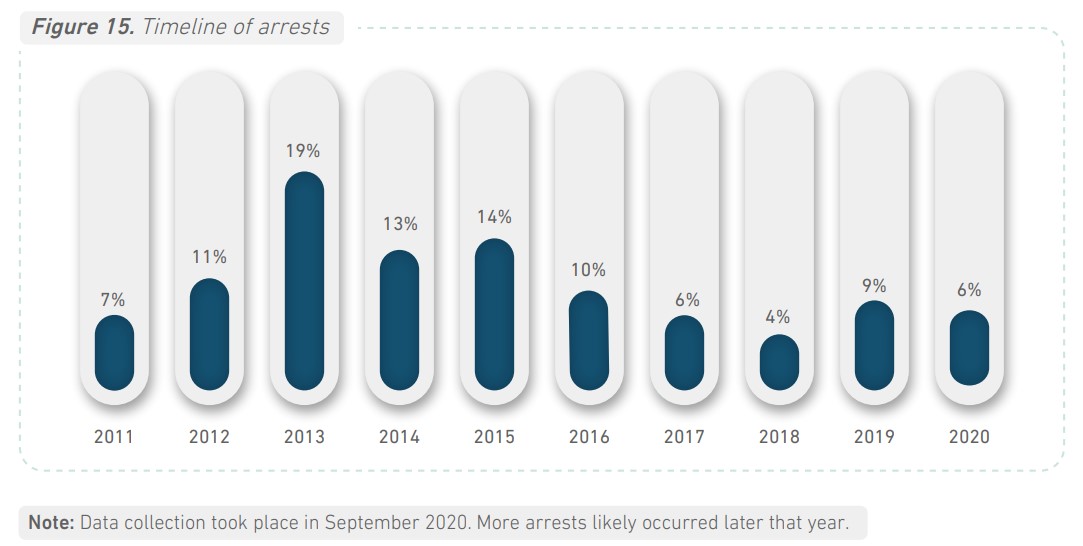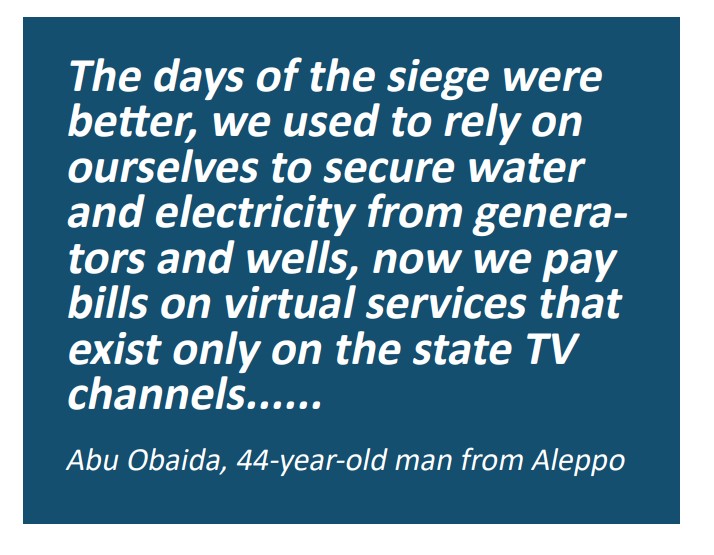A critical component of safe, dignified and voluntary return is access to reliable information about whether it is safe to return. This information helps the displaced understand whether their return conditions have been met, as well as the process involved. In particular, it might help highlight any inconsistencies between the process and their legal rights as refugees and IDPs to return home without fear of harassment or targeting. Previous SACD research shows that a staggering 87 per cent of surveyed Syrian refugees were confident that they had enough information through informal channels to judge whether their return conditions had been met in their areas of origin; informal sources such as family and media were their main sources of information. However, further questioning revealed they were unaware of critical and potentially life-threatening components of the regime’s requirements for return.
A closer examination of one key mechanism used by the regime in dealing with refugees who are considering returning now shows that their sense of being informed about the conditions on the ground is utterly misguided. SACD surveys revealed a potentially dangerous lack of real information from those supposed to be informing them on all aspects of return conditions, including the UNHCR.
People who wish to return to Assad-held areas must now sign a “reconciliation document” in order to return—particularly those who left the country without official documents or permission, as is the case for many refugees. The content of the document, which must be lodged with the Syrian embassy in the host country before being allowed to return, speaks of “addressing the situation of Syrians who left the country illegally, due to the current circumstances and (…) settling their military conscription and other security issues, regardless of the circumstances that compelled them to leave”. Signing the document amounts to a confession of having committed a legal violation by leaving the country.
Some 80 per cent of people surveyed by SACD stated they did not have any meaningful information about the content of this document. Of the 20 per cent who did have some information about it, most believed it was tantamount to an admission of committing crimes against the state. When asked if they thought that such an admission could later be used against them in criminal proceedings—either by raising a personal lawsuit or raising a public right claim—nearly 54 per cent reported that they were aware of the possibility of being prosecuted under the reconciliation document; 46 per cent indicated that they did not know if it was possible to be prosecuted according to this document.
Study participants who wish to return were asked about their willingness to sign the reconciliation document, and 98 per cent of those wishing to return confirmed that they would not sign, and that this document would be an obstacle to their return.
This practice is seen as a major obstacle to return, epitomising the regime’s continued subjugation of potential returnees. The series of responses about the reconciliation process highlights another worrying trend. Despite 87 per cent of people stating that they had adequate information about returning and the conditions for return, nearly the same percentage had no information about the “reconciliation process”. When given the information during the survey, they then said this would present a major barrier to return. These responses make it clear that refugees and IDPs do not currently have adequate information about the conditions or returns processes and their potential to violate both their rights as IDPs and refugees, and to risk their personal security and freedom in the future.
UNHCR’s reporting tools, designed to provide granular information and analysis of obstacles and conditions for return, and identifying the necessary actions to address them, simply do not exist. Its monthly Operational Update, itself geared towards member states and donors, sets out various sets of numbers, including those of “spontaneous returns,” different ways that the agency is helping the refugees and returnees, with a heavy emphasis on the donor-driven language of “impact” and not a single mention of specific obstacles to return or reality facing those forced to return due to difficult living conditions or anti-refugees’ sentiment in host countries.
It speaks of gathering information at the community level to inform on gaps in infrastructure and services, and “other recent developments” that may have an impact on Syrians’ return, but such document is not publicly available or accessible by the displaced Syrians. It indicates that such a document compiles laws that Assad’s regime has passed to supposedly “facilitate” return without monitoring their implementation or impact on refugees’ intentions. It makes no mention of the series of discriminatory laws and decrees passed by the regime aiming to strip the displaced Syrians of their properties and tenancy rights, such as Law 10 or Law 6.
Most importantly, the Operational Update nor any of the other UNHCR’s public documents does not make a single mention of the security risks for returnees or its lack of access to monitor and report on its own protection thresholds in the majority of Assad-held areas.
In addition to this consistent failure to inform the displaced people through its own public communication of the reality in Assad-held areas, UNHCR’s own communication assets such as social media accounts or statements by senior officials are sending mixed messages which give an impression that it is safe to return, thus directly encouraging premature and uninformed returns, which often lead to persecution and suffering of returnees.
A number of such cases were reported on by SACD, including during the UNHCR’s head Filippo Grandi’s visit to Eastern Ghouta or meetings with the Syrian regime officials in Damascus. Such repeated messaging of this kind on similar occasions, which consistently fails to address the security threats facing potential returnees, speaks of a systematic approach which paints a deeply misleading picture of the reality in Syria. This speaks of UNHCR’s failure to fulfil the Syrian refugees’ right to know about the conditions facing them in several key areas:
- Failure to report accurately, promptly and comprehensively on the security threats, arbitrary arrests, forced recruitment, harassment, extortion, lack of basic services and other forms of abuse suffered by a significant number of refugees and IDPs who returned to Assad-held areas to date;
- Failure to transparently report on UNHCR’s lack of access to monitor conditions in potential return areas or the condition of returnees in the large majority of Assad-held areas and inform the relevant international bodies and facilitate appropriate political or policy discussions affecting displaced Syrians;
- Failure to include a comprehensive, detailed and contextually-aware reporting on its own protection thresholds in its regular reports, including Operational Updates and other UN reporting tools such as HNAP Returnee Overview, thus contributing to a skewed, misleading picture on the situation awaiting returnees, which has serious consequences many who lack basic information on the reality in Assad-held areas before making the decision to return;
- Failure to clearly communicate to the relevant international bodies that it has no way to ensure that returnees are not persecuted by the regime, which should be an absolute minimum before any conversation on the return of the displaced occurs.
The UNHCR must, therefore, cease the misleading messaging on the “improving security situation” for returnees, and improve communication, information, and counselling with Syria’s displaced to ensure they are aware of all factors and conditions that might impact their returns decisions, including information about how current conditions and returns procedures impact their rights, and make this communication approach an integral part of future media campaigns.
Below is the detailed breakdown of descriptions of protection thresholds not being met.
- UNHCR Protection Threshold 1
- UNHCR Protection Threshold 2
- UNHCR Protection Threshold 3
- UNHCR Protection Threshold 4
- UNHCR Protection Threshold 5
- UNHCR Protection Threshold 6
- UNHCR Protection Threshold 7
- UNHCR Protection Threshold 8
- UNHCR Protection Threshold 9
- UNHCR Protection Threshold 10
-
- UNHCR CPSS Protection Threshold: Significant and durable reduction of hostilities.
The Normalization of Horror report issued by the Syrian Association for Citizens’ Dignity in 2021 found that about 50 per cent of respondents in Assad-controlled areas do not feel safe, including those who did not leave immediately. Most of them refer to the grip of the security authorities, insecurity, and outbreaks of violence. Crime is a reason for not feeling safe, and 67 per cent of returnees from outside Syria do not feel safe. Those who live in the areas of reconciliation are the worst, with 94 per cent saying they do not feel safe. They indicated that there are no secure areas, and some practical safety measures show that security is fragile everywhere; Because of the security policies by the same authority.
According to SACD research, 79 per cent of the respondents expressed their resentment at the absence of the rule of law and the extreme deterioration of the security service.
The annual report issued by SNHR launched at 15th March 2022 documented that 228,647 Syrian Civilians were Killed, including 14,664 by torture, with 151,462 arbitrarily detained/forcibly disappeared, and 14 million others Displaced.
According to the latest report issued by the SNHR, the information records the killing of 67 civilians, including 20 children and three women, at the hands of the parties to the conflict and the controlling forces in Syria in March 2022, of whom the Syrian regime killed seven civilians, including one child. While Hay’at Tahrir al-Sham killed one woman, ISIS killed one civilian. It also recorded the killing of 5 civilians at the hands of the Kurdish-led Syrian Democratic Forces. According to the report, 53 civilians, including 19 children and two women, were killed by other parties.
According to the same report, the analysis of the data showed that the Daraa governorate, supposed to be a reconciliation area where military operations stopped years ago, topped the rest of the governorates with approximately 40 per cent of victims documented in March 2022, followed by Deir Ezzor governorate with approximately 21 per cent, while Aleppo came in third with about 16 per cent of the casualties.
Hostilities do not mean only military actions such as shelling, bombings, and battles, but also arrests, enforced disappearances, field liquidations and other crimes are among the hostile acts carried out by the Syrian regime towards the Syrian people, just as reducing hostilities does not mean killing several people. Less than the Syrian people are at the hands of the regime, but rather stopped completely and permanently. In 2021, the Syrian regime and its Iranian and Russian allies killed 326 people, in addition to the liquidation and killing operations carried out by the Syrian Democratic Forces, which killed 75 people and other military forces that target the Syrian people. In 2021 the Syrian regime arrested 1032 people, including 23 women and 19 children.
SACD also documented 520 cases in the countryside of Damascus, Daraa, and northeastern Syria, distributed between kidnappings and arrests by military forces on the ground.
These statistics and others are an indication that the hostilities against the Syrian people did not stop and are continuing without interruption, decline or relentlessness.
SACD’s research has also found that the proportion of detainees among the participants since the beginning of the conflict is high; but it confirms that this trend is still continuing, as there was a noticeable increase in 2019 and 2020 until September compared to 2018, despite the fact that the regime was launching major military attacks on Idlib and Aleppo in 2018 and gaining more land.
-
- UNHCR CPSS Protection Threshold: Conclusion of a formal agreement with the government, host countries, and other actors as required to receive returnees.
According to SACD research, 94 per cent of the participants who feel insecure are those who conceded to so-called Personal Legal Status Settlements as part of their overall ‘reconciliation agreement’, while 72 per cent of the returnees arrested were covered by the regime’s alleged pardon decrees and/or entered into Personal Settlements after staying in areas of reconciliation.
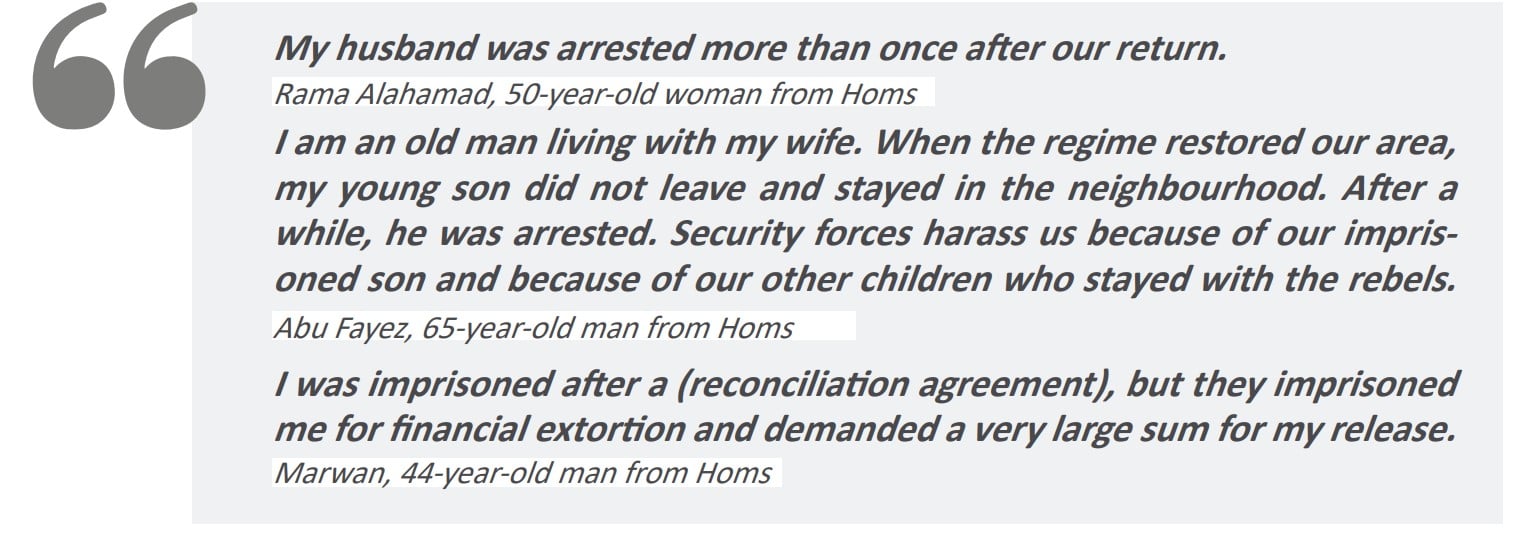 Up until 2022, and despite holding more than one conference in Damascus to call for the return of Syrian refugees, no country hosting Syrian refugees has concluded an agreement with the Syrian regime regarding returns. Yet some hosting countries are pursuing policies that force Syrian refugees into an unsafe and premature return, despite the fact that these refugees do explain the dangers they will face upon such return.
Up until 2022, and despite holding more than one conference in Damascus to call for the return of Syrian refugees, no country hosting Syrian refugees has concluded an agreement with the Syrian regime regarding returns. Yet some hosting countries are pursuing policies that force Syrian refugees into an unsafe and premature return, despite the fact that these refugees do explain the dangers they will face upon such return. Amnesty International’s report in September 2021 titled “You are going to die: violations against Syrian refugees returning to Syria” emphasized that Syrian intelligence officers have subjected women, children and men returning to Syria to unlawful or arbitrary detention, enforced disappearance, torture, and other ill-treatment, including rape and sexual violence. All returnees face the allegations that they were affiliated with the opposition groups, which puts their lives upon return at grave danger. Based on these findings, Amnesty International concluded that there is no safe area in Syria for the refugees to return to, including the capital Damascus and its surrounding areas, and that people who have left Syria since the outbreak of the conflict there are at real risk of persecution upon return. The report stated that the Lebanese authorities deported about 6,000 Syrian citizens between mid-2019 and the end of 2020, which essentially violates the principle of non-refoulment.
-
- UNHCR CPSS Protection Threshold: The government/actors in control of the return area provide genuine guarantees that returnees will not face harassment, discrimination, arbitrary detention, physical threat, or prosecution on account of originating from an area previously Or currently under de facto control of another party to the conflict; for having left Syria illegally; for having lodged an asylum claim abroad, or on account of any (individual or family) diversity characteristic.
In one of SACD’s surveys, two-thirds of the interviewees stated they live in constant fear of arrest or harassment from the security services and various militias that run a maze of checkpoints—particularly those in or from areas under “reconciliation agreements.” Militias rely on a network of informants to identify returnees and those who accept “reconciliation agreements” for targeting. People are stopped, harassed, threatened, and arrested by these groups to extort money on the spot or from their families.
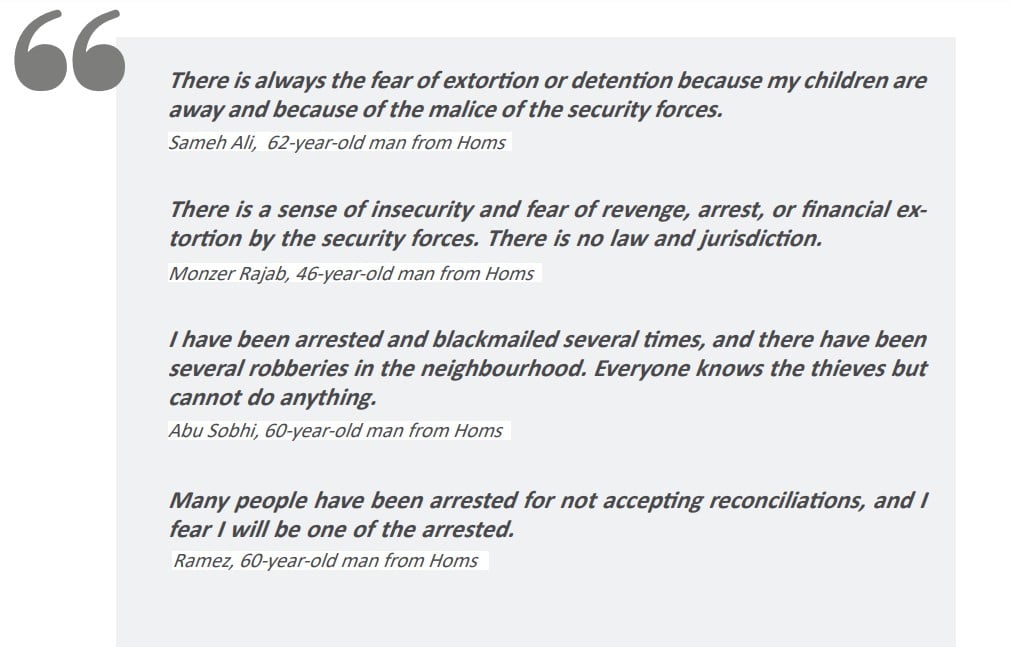 Corruption and extortion by the regime and militias permeate every aspect of life for returnees. Interviewees reported having to pay bribes to carry out the most menial of activities, such as obtaining documents or transporting produce to the market. Almost all industrial and other economic activity in these areas has ceased, so farming is often the sole source of income. The regime is exploiting this situation by enforcing a ban on the transfer of goods and products beyond local areas under “reconciliation agreements”, which forces returnees to sell their produce to the pro-regime monopolists.
Corruption and extortion by the regime and militias permeate every aspect of life for returnees. Interviewees reported having to pay bribes to carry out the most menial of activities, such as obtaining documents or transporting produce to the market. Almost all industrial and other economic activity in these areas has ceased, so farming is often the sole source of income. The regime is exploiting this situation by enforcing a ban on the transfer of goods and products beyond local areas under “reconciliation agreements”, which forces returnees to sell their produce to the pro-regime monopolists. Two-thirds of the returnees have lost their former source of income and are now unemployed or engaged in manual, temporary work that cannot provide a basic standard of living for their families.
According to the same survey, 48 per cent of the participants stated that they or their family members were wanted by the regime security branches for reasons related to anti-regime civilian activities, even including anti- regime sentiments.
72 per cent of the returnees who were arrested were covered by the regime’s alleged pardon decree No. 13 and/or entered into personal settlements after remaining in these areas after reconciliation agreements.
 55 per cent of returnees were forced to move, compared with 45 per cent of residents who never left.
55 per cent of returnees were forced to move, compared with 45 per cent of residents who never left. 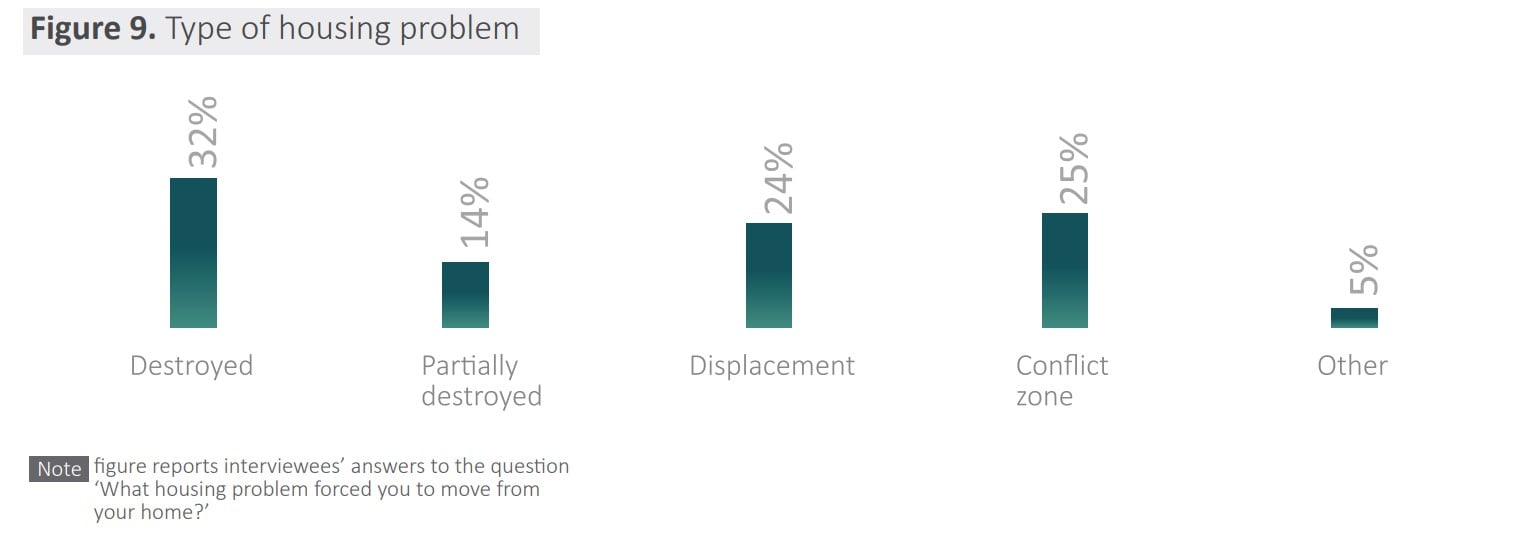 61 per cent of respondents reported suffering at least one form of harassment such as threats to be detained, accusations of treason and destroying the country, in addition to verbal and sexual harassment for women on regime check points. These adverse practices seem to target residents and returnees differently.
61 per cent of respondents reported suffering at least one form of harassment such as threats to be detained, accusations of treason and destroying the country, in addition to verbal and sexual harassment for women on regime check points. These adverse practices seem to target residents and returnees differently. 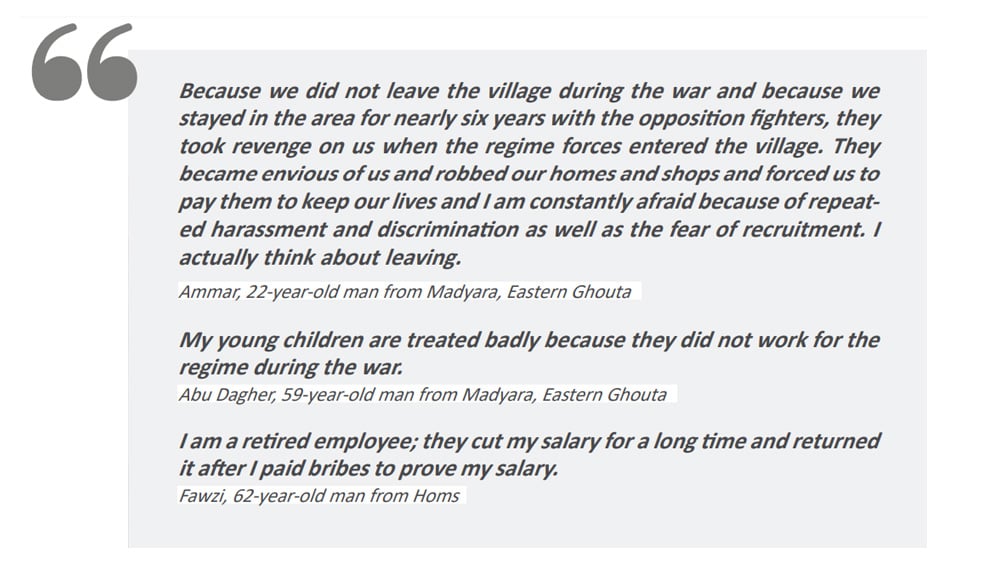
SACD’s research has shown that about 50% of people in Assad-controlled areas reported that they do not feel safe, including those who have never left. 67% of returnees from outside Syria do not feel safe. Safe, and those who live in reconciliation areas are the worst off, as 94% say they do not feel safe. 61% reported suffering at least one form of harassment as threatening to be detained, accusations of treason, and destroying the country, in addition to verbal and sexual harassment of women in regime checkpoints.
-
- UNHCR CPSS Protection Threshold: Every individual’s decision to return is informed and genuinely voluntary, without any coercion.
The reality in Syria is such that despite the dire conditions Syrians are suffering in displacement, whether internally or in some of the host countries, they are still unwilling to return. This is primarily due to the fact that the conditions which caused the displacements are still in place and active and the regime continues to repress the areas it controls. It is necessary to emphasize the danger of misleading Syrians about the existence of a safe environment in Syria. Premature return will result in no solution, it will violate their lives and contribute to lasting instability and the waves of displacement will continue.
Internal progress of host countries will certainly not be accomplished through the politicization of refugees. On the contrary, this will only end in dehumanizing rhetoric and behavior, creating more problems. And distracting from the main issue in Syria: pushing forward the political process with a focus on a safe environment and securing the conditions for a real safe, voluntary, and dignified return as defined by Syrian displaced themselves.
SACD research results illustrate the disappointment of many returnees after their return, as 62 per cent of those who returned to regime-held areas expressed disappointment. Some of them described their return as a “stupid decision” and felt deluded for believing the regime’s propaganda about the situation’s stability. Furthermore, 73 per cent of interviewees in areas the regime took by force would like to leave. This desire to leave reflects the state of resentment towards the abuses and violations to which citizens are frequently subjected in those areas. 84 per cent do not advise others to return to regime-held areas.

According to SACD’s “Between Hammer and Anvil” survey report, 48 per cent of returnees to regime-held areas left once again when they experienced the reality shock in regime-held areas when it comes to security and living conditions. 68 per cent were dissatisfied with their decision to return. 65 per cent of returnees stated that they achieved nothing by returning because either they were stuck in the poor living and economic conditions prevailing in the regime areas, were subjected to harassment, arbitrary arrest, or feared forced recruitment to Assad’s military.

Earlier, Denmark issued a report that Damascus Governorate had become safe and could be returned. Still, Amnesty International informed the Danish authorities in December 2021 that the latter “made several inaccurate statements” in its recent reports. In its letter, Amnesty International criticized what it described as an “incredible approach,” warning that “there are no guarantees that the Syrian authorities’ agreement to settle the situation will protect individuals from arbitrary detention.”
In the absence of reliable information networks on which Syrian refugees can make informed return decisions and humanitarian agencies with insufficient access, and thus inability to monitor voluntary return and reintegration in Syria, Human Rights Watch called on all countries hosting Syrian refugees to adopt the position that they Syria is considered unsafe to return. HRW asserted that international donor governments must use their leverage to counter practices such as summary deportations and forcible returns to Syria, which amount to a breach of non-refoulement obligations.
SACD’s Weaponization of Aid report explains how the Syrian regime turns humanitarian aid into a weapon and controls the aid provided to the populations in regime-held areas. The survey results of the report have shown that about 58 per cent of the respondents described the levels of corruption in international and local humanitarian organizations operating in regime-controlled areas as ranging from medium to very high. Approximately 44 per cent of the participants believe that more than 25 per cent of the humanitarian aid allocated to the areas controlled by the Syrian regime is transferred to military parties and militias, while 16 per cent of the participants believe that the actual percentage is higher; from 50 to 75% of the aid.
 75 per cent of the respondents who live in the regime’s areas are not satisfied with the behavior of the Syrian regime, and 89 percent of the respondents expressed their dissatisfaction with all the living conditions in the areas The regime, whether from the security, service, or economic aspect. Almost half of the participants seek to leave these areas.
75 per cent of the respondents who live in the regime’s areas are not satisfied with the behavior of the Syrian regime, and 89 percent of the respondents expressed their dissatisfaction with all the living conditions in the areas The regime, whether from the security, service, or economic aspect. Almost half of the participants seek to leave these areas. 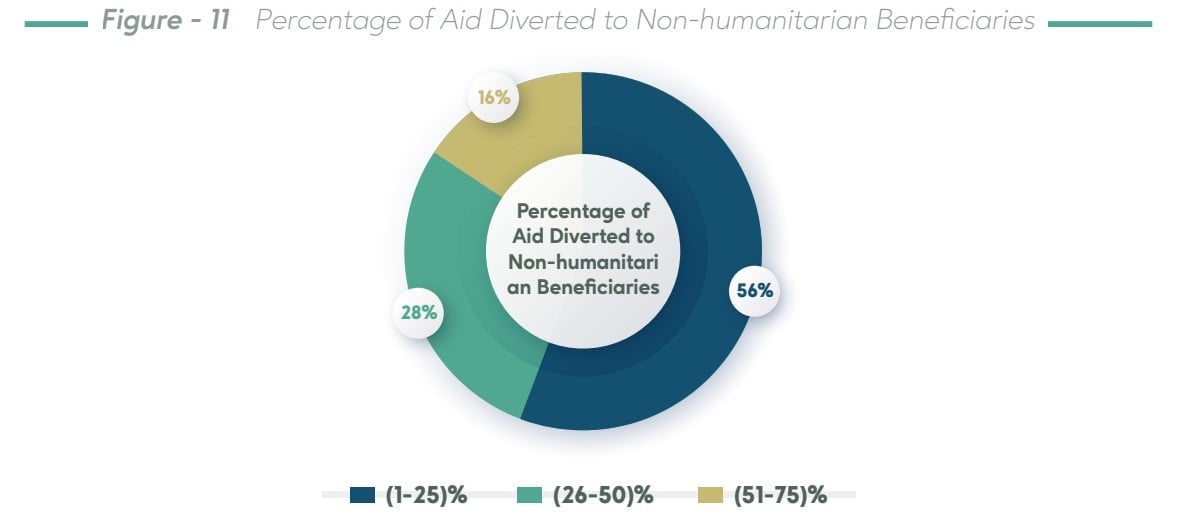
-
- UNHCR CPSS Protection Threshold: Acceptance by the government/entity in control of the return area of returnees’ free choice of destination, place of residence, and right to freedom of movement.
The Syrian regime has been issuing administrative laws to reconstruct the destroyed areas. Still, the undeclared goal of these decisions is to prevent the return of refugees to their original homes. One of these laws is Law No. 10 of 2018, which states that one or more administrative areas may be created within the general organizational scheme of administrative units; another primary concern is the law’s timeframe, as once a local authority announces a redevelopment plan – which has not yet happened – people will have 30 days to provide proof of ownership. If they don’t, they will not be compensated, and the property will return to the town or the district or city in which the property is located.
In addition to Law No. 10, the Syrian regime has issued more than 45 housing, land, and property laws since the crisis. Yet one of the main ways the Syrian regime uses demolitions, and thus prevents the return of civilians, is through Law No. 3 of 2018 regarding the removal of the ruins of damaged buildings because of natural or unnatural causes or because they are subject to the laws requiring their demolition.
SACD’s research has shown that 40 per cent of returnees could not recover their original homes for reasons of partial or total destruction or because of the security measures that have impeded the return. Only 60 per cent of returnees could return to the place of residence they lived in before leaving. 24 per cent could return to the same neighborhood, but not the same house. 18 per cent could not return to their neighborhoods or towns; they returned to other areas. The Syrians have the right to give them a real and influential voice in the political discussions that will determine their fate because any mistake in defining or implementing a safe environment will likely cost their lives and dignity.
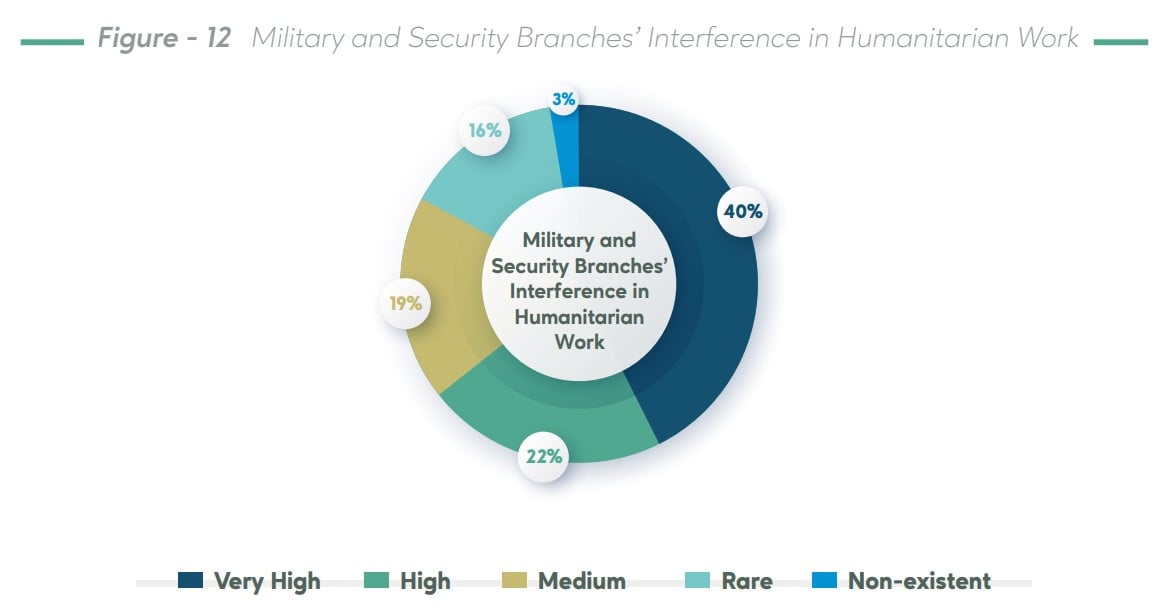
-
- UNHCR CPSS Protection Threshold: The physical, legal and material safety of refugees and returnees is ensured.
More than half of the Syrian population is displaced as a direct result of war crimes and crimes against humanity overwhelmingly against Syrians by the Syrian regime and its allies. The most destructive pattern of abuse is the indiscriminate arrests and detention by the security services without a charge. The main fears are arbitrary arrests, forced conscription, harassment, forced disappearance, to name some, and a chaotic security situation caused by the presence of forces and various militias.
SACD surveys has shown that more than a quarter of those interviewed had been detained or had a family member arbitrarily arrested. Of those respondents, 75% had been arrested within the last 18 months. More than 70% of those detained had to pay a bribe to be released.
Beating and torture are standard practices in detention. Several interviewees’ relatives were taken to unknown locations, after which they were never heard from again. 65% of the respondents in this study (68% of men and 59% of the women interviewed) acknowledged that they do not feel safe in the regime-held areas.
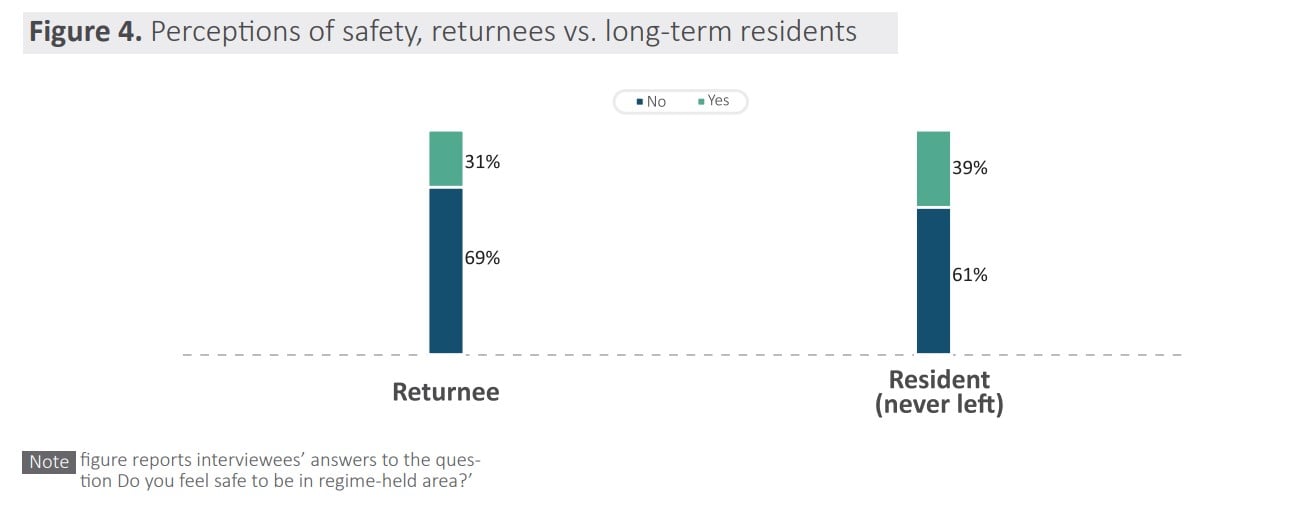 Reconciliation agreements appear to make residents feel less safe. 74% of respondents in areas where the regime control was restored through reconciliation agreements feel unsafe, compared to 64% in areas without such agreements.
Reconciliation agreements appear to make residents feel less safe. 74% of respondents in areas where the regime control was restored through reconciliation agreements feel unsafe, compared to 64% in areas without such agreements. 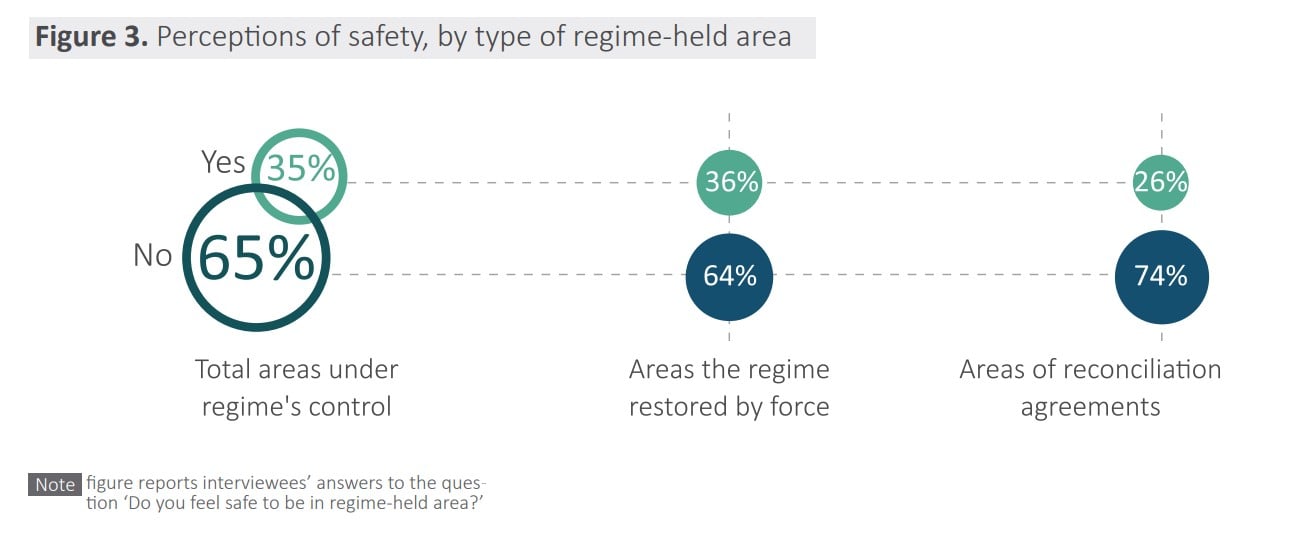
-
- UNHCR CPSS Protection Threshold: Returnees fully benefit from an amnesty in Syria, except for those that are charged with a serious violation of international humanitarian law, or a crime against humanity, or a crime constituting a serious violation of human rights, or a serious common crime involving death or serious bodily harm, committed prior to or during exile. The amnesty includes those who evaded compulsory military service or reservist service, have deserted from the armed forces, have joined a non-state armed group, and who left Syria illegally and/or lodged an asylum claim abroad.
The Syrian regime uses amnesty decrees to entice displaced Syrians to return back to an unsafe Syria, where it continues to arbitrarily detain tens of thousands of detainees. For over a decade, the regime has been deploying its media machine to manipulate public opinion and cover its crimes and practices through amnesty decrees after relentlessly killing, torturing, imprisoning, starving, and displacing its people. After the Tadamon neighborhood massacre has been revealed to the world, the Syrian regime resorted to issuing an amnesty decree to save its face.
Some 68 per cent of those interviewed by SACD surveys are themselves or have a relative who is wanted for arrest by either the security services or Assad’s military. Forced conscription into Assad’s forces is rampant, especially in areas integrated under “reconciliation agreements”, where up to 75 per cent of those interviewed or their family members were wanted for recruitment. Conscripted fighters are almost inevitably sent to the most dangerous frontlines; many, especially young men, have been killed either in battle or in murky circumstances. Many of those wanted by the security branches for being perceived as “anti-Assad” are forced into the military and sent to the frontlines straight from detention and are never seen again.
 The survey report also indicates how half of the respondents attributed their feelings of insecurity to the fact that they or a family member were in danger of being arrested because they were against the regime (fear of being arrested). Forced conscription into Assad’s forces is rampant, especially in areas integrated under “reconciliation agreements,” where up to 75 per cent of those interviewed or their family members were wanted for recruitment. Conscripted fighters are almost inevitably sent to the most dangerous frontlines; many, especially young men, have been killed in battle or murky circumstances.
The survey report also indicates how half of the respondents attributed their feelings of insecurity to the fact that they or a family member were in danger of being arrested because they were against the regime (fear of being arrested). Forced conscription into Assad’s forces is rampant, especially in areas integrated under “reconciliation agreements,” where up to 75 per cent of those interviewed or their family members were wanted for recruitment. Conscripted fighters are almost inevitably sent to the most dangerous frontlines; many, especially young men, have been killed in battle or murky circumstances. Furthermore, our surveys with returnees indicated that 1 per cent of the total respondents returned because of amnesties, and this low percentage reflects the returnees’ mistrust of the amnesty decrees. 37 per cent of returnees or one of their relatives had been wanted by security services and had dared to return because they could not endure life in areas of displacement or asylum.
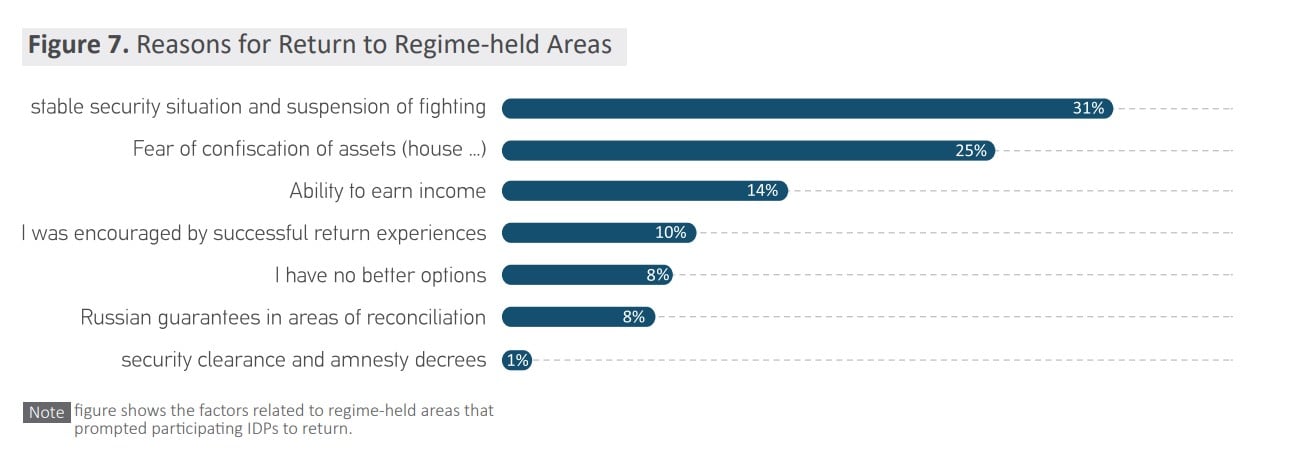
SACD findings have shown that 19 per cent confirmed that the arrests were against people previously covered by one of the amnesty laws and decrees issued by the regime, and 26 per cent had signed reconciliation agreements.
 Among the respondents whose relatives are supposed to be covered in theory by the amnesty decrees issued, 79 per cent of them did not benefit from these decrees. There was no release of people from their communities due to the amnesty laws. The rest of the respondents were divided into 21 per cent of the respondents who mentioned the positive effects of the amnesty decisions on the actual value of these decisions, and only 12 per cent who believed that the benefit of these decrees is real; While the rest said that the people who benefited from the amnesty decrees have either already had completed their sentence, or were arrested shortly before the laws were issued without any reason.
Among the respondents whose relatives are supposed to be covered in theory by the amnesty decrees issued, 79 per cent of them did not benefit from these decrees. There was no release of people from their communities due to the amnesty laws. The rest of the respondents were divided into 21 per cent of the respondents who mentioned the positive effects of the amnesty decisions on the actual value of these decisions, and only 12 per cent who believed that the benefit of these decrees is real; While the rest said that the people who benefited from the amnesty decrees have either already had completed their sentence, or were arrested shortly before the laws were issued without any reason. 
 The regime forces continued to pursue and arrest people who settled their security situation in the areas that had previously signed settlement agreements with him and concentrated in the governorates of Aleppo, Damascus countryside, and Daraa. Before 2020, at least 307 arrests were against people who had settled their security situation.
The regime forces continued to pursue and arrest people who settled their security situation in the areas that had previously signed settlement agreements with him and concentrated in the governorates of Aleppo, Damascus countryside, and Daraa. Before 2020, at least 307 arrests were against people who had settled their security situation. According to the documentation of the Voice of the Capital, more than 200 of those who signed settlement agreements and allegedly “volunteered” in the ranks of the regime forces and its militias from the eastern and western countryside of Damascus have been killed on the fighting fronts in northern Syria since the beginning of 2019. Also, the Voice of the Capital documented, during 2019, more than 1,200 cases of arrests carried out by the intelligence of the Assad regime and its military checkpoints in and around Damascus, including several settlement elements and those wanted for compulsory and reserve military service, in addition to many women, on charges of telephone contact with wanted persons by the regime. Several young men were also arrested on charges that “regime intelligence” said were related to “terrorism”.
-
- UNHCR CPSS Protection Threshold: The Government sets up efficient, accessible, and affordable mechanisms to address housing, land, and property (HLP) issues and to provide for property restitution and compensation in line with international law. Particular attention needs to be paid to the rights of returnee women heads of households and the rights of secondary occupants of refugees’ property.
The Syrian regime, through laws such as Law No. 10 and others, seeks to confiscate the property of displaced Syrians to make their return more challenging. It is part of a systemic pattern of violations to strip the original owners of their properties and re-appropriate them to the regime-friendly business people or members of its forces. These decrees and laws are always made under the guise of “re-organization” or reconstruction, but they aim to cement displacement and ultimately result in demographic change.
SACD survey report found that most interviewees from areas covered by the regime’s “urban development laws” consider themselves affected by the discriminatory laws and decrees governing the destroyed areas. They are systematically denied the right to their property in an open retaliatory manner, especially in areas where the regime has seized control by force.
More than two-thirds (70 per cent) of the respondents reported that their residence was interrupted for various reasons related to the conflict. This percentage was higher (93 per cent) among respondents in the areas restored through the regime’s military campaign and without reconciliation agreements.
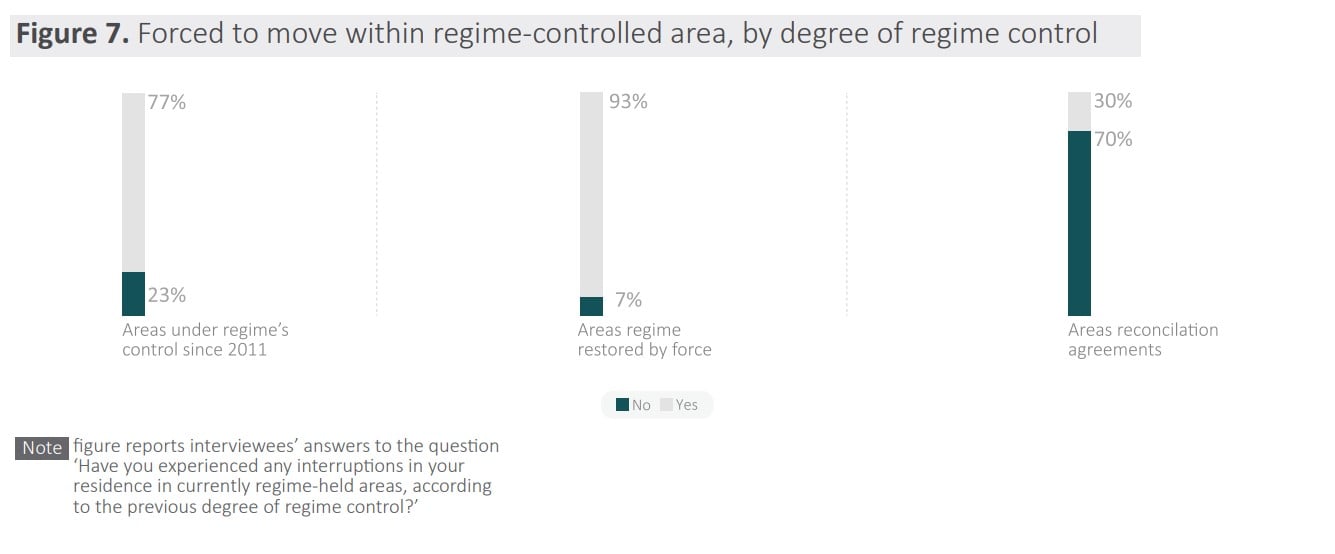
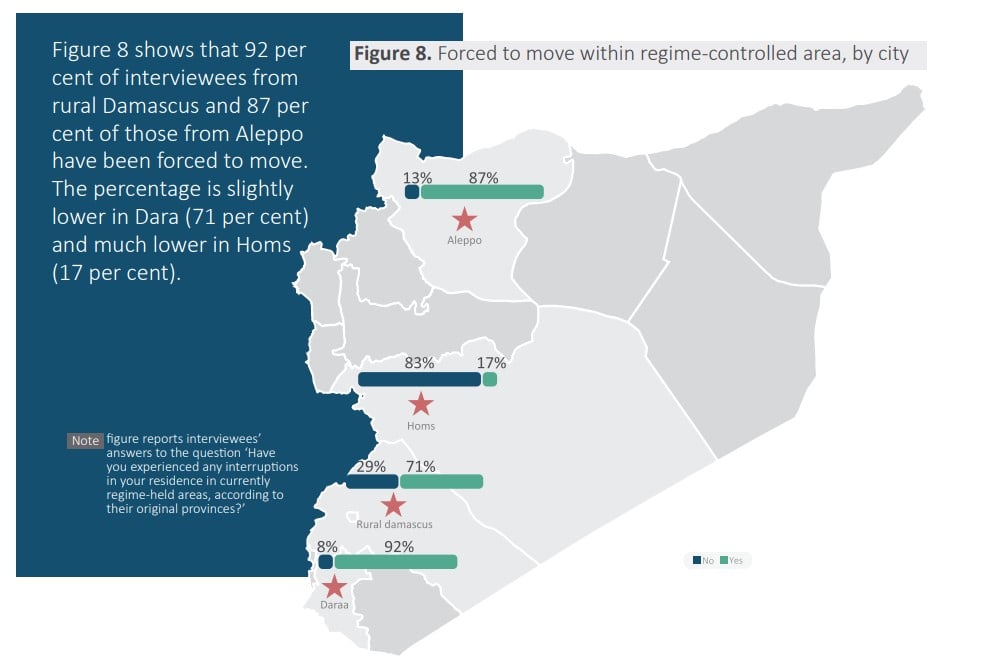 The study has also shown that people are risking their safety by returning to regime-controlled areas to officially claim their property and ensure that they do not lose it. Several interviewees in Ghouta noted that citizens who are at risk of arrest may send older relatives to visit government offices on their behalf, which increases the vulnerability of these relatives. Residents who have attempted to return home or simply check on their properties have found little evidence of the supposedly rich legal framework backing the government’s reconstruction efforts. Blocked from returning to rehabilitate, let alone visit, their former homes, displaced Syrians now living in other areas of the country are uncertain about what the future holds.
The study has also shown that people are risking their safety by returning to regime-controlled areas to officially claim their property and ensure that they do not lose it. Several interviewees in Ghouta noted that citizens who are at risk of arrest may send older relatives to visit government offices on their behalf, which increases the vulnerability of these relatives. Residents who have attempted to return home or simply check on their properties have found little evidence of the supposedly rich legal framework backing the government’s reconstruction efforts. Blocked from returning to rehabilitate, let alone visit, their former homes, displaced Syrians now living in other areas of the country are uncertain about what the future holds. Militias occupy homes and prevent their owners from returning to them, steal their contents, and steal machines from local workshops. They also extort money from citizens who are rebuilding their destroyed homes by threatening to prevent them from building. In addition, respondents mentioned that pro-regime militants press real estate owners for selling their properties for less than 20 per cent of their market value; they exploit owners returning from opposition areas and the relatives of opposition fighters.
SACD Information Monitoring Unit obtained a copy of the new list, which included lands of varying sizes, totaling more than 1,500 hectares, owned by Syrian citizens wanted by the security forces of the regime’s security services and residing outside the areas of its control, inside and outside Syria, who are from the city of Mohassan in the countryside of Deir Ezzor. According to the list signed by the Governor of Deir Ezzor Fadel Najjar, the governorate offered these lands for investment through committees formed.
The confiscated lands were offered for investment for 2021-2022 through auctions. Holders of an investor card (the card is not extracted except with complicated security approvals) are entitled to apply for land investment.
Moreover, further SACD research has shown that 40 per cent of returnees could not recover their original homes for reasons of partial or total destruction or because of the security measures that have impeded their return.
-
- UNHCR CPSS Protection Threshold: The principle of family unity is upheld, including a right to enter and remain for dependents who are not Syrian citizens.
The family unit is the backbone of Syrian society, and it has been dramatically affected by the conflict, with family members dispersed in displacement, detained, or killed. Family reunion plays an essential role as a condition for return. This is a focal point in understanding the social impact of forced displacement and the social needs necessary to achieve a joint return in Syria.
SACD research revealed that 33 per cent of returnees were unable to achieve their goal of family reunion upon their return, which led to their terming of the return experience as “a wrong and disappointing decision”.
One-third of the participants in the study could not reunite with their families after returning for several reasons, such as the inability of other family members to return because they are wanted by security services or compulsory military service. Hence the issue of return cannot be addressed at the individual level; it ought to be handled through a comprehensive solution and an organized collective, voluntary, safe and dignified return.
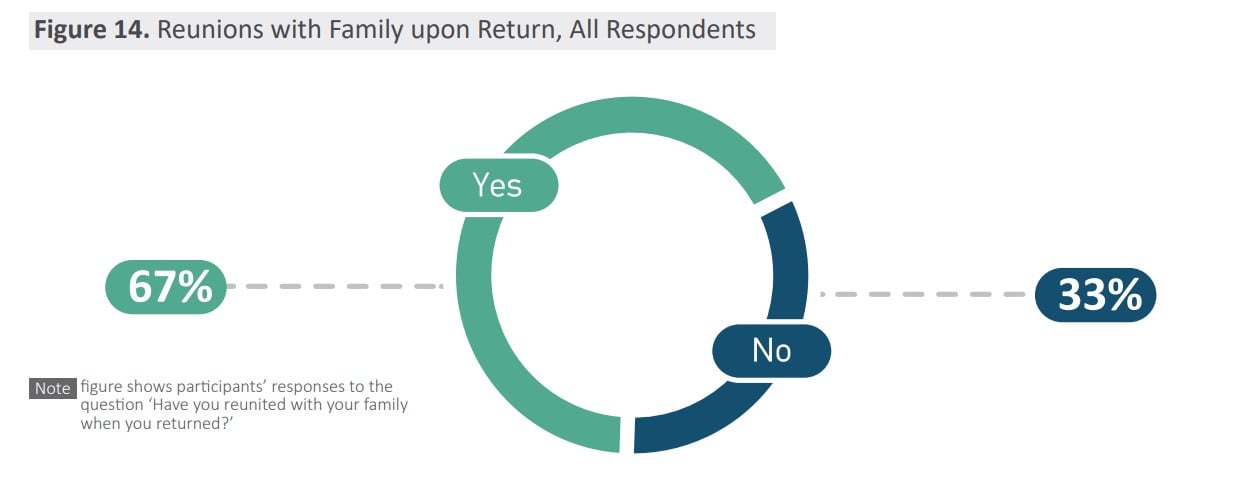
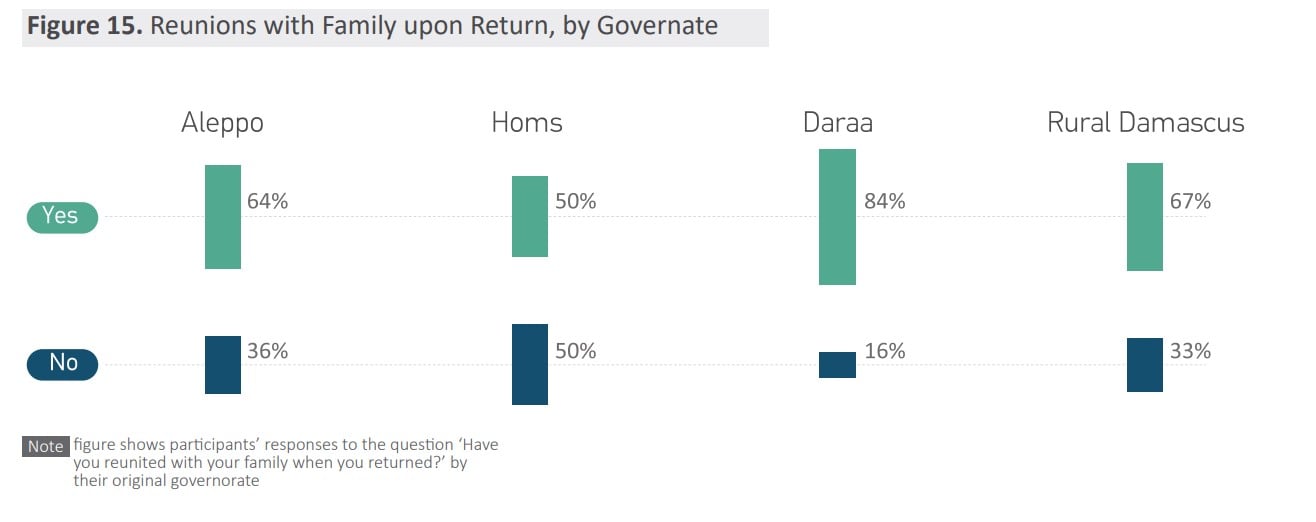
-
- UNHCR CPSS Protection Threshold: Returnees enjoy free access to law enforcement bodies, courts of law, competent administrative authorities, and other relevant entities.
The regime’s security forces and the military checkpoints have become more like official fee collection centers that share citizens’ limited resources and impose the payment of bribes under false pretenses, such as security procedure requirements. Returnees to regime-held areas have been particularly let down by the regime’s failure to honor laws that it claimed were designed to protect Syrian citizens.
SACD surveys have revealed that 79 per cent of interviewees expressed resentment at the absence of the rule of law and the extreme deterioration of the security services. 97 per cent expressed their disappointment with the spread of corruption at different levels in all aspects of civilian life. 71 per cent reported that their civil rights had been violated.
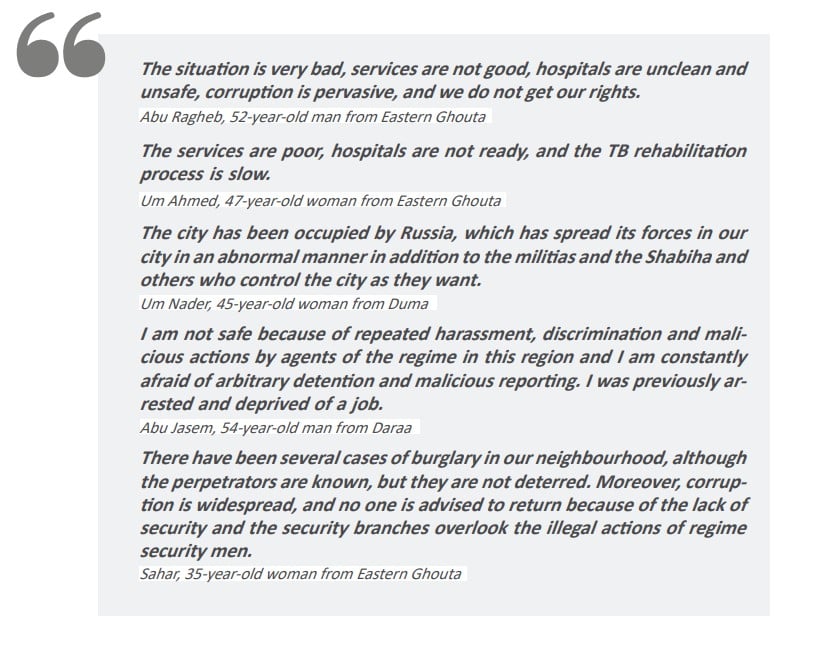 SACD surveys with Syrians living in Assad-held areas have revealed that 53 per cent of the relatives of the arrested participants are held in unknown places. It is impossible to visit them, nor can information be obtained about their cases or the reasons for their arrest, violating international laws and covenants that guarantee their rights. 52 per cent said that they believe it is unhelpful to report corruption because they believe that corruption occurs with the blessing and oversight of enterprise managers and officials and that the system shows no genuine interest in fighting corruption.
SACD surveys with Syrians living in Assad-held areas have revealed that 53 per cent of the relatives of the arrested participants are held in unknown places. It is impossible to visit them, nor can information be obtained about their cases or the reasons for their arrest, violating international laws and covenants that guarantee their rights. 52 per cent said that they believe it is unhelpful to report corruption because they believe that corruption occurs with the blessing and oversight of enterprise managers and officials and that the system shows no genuine interest in fighting corruption.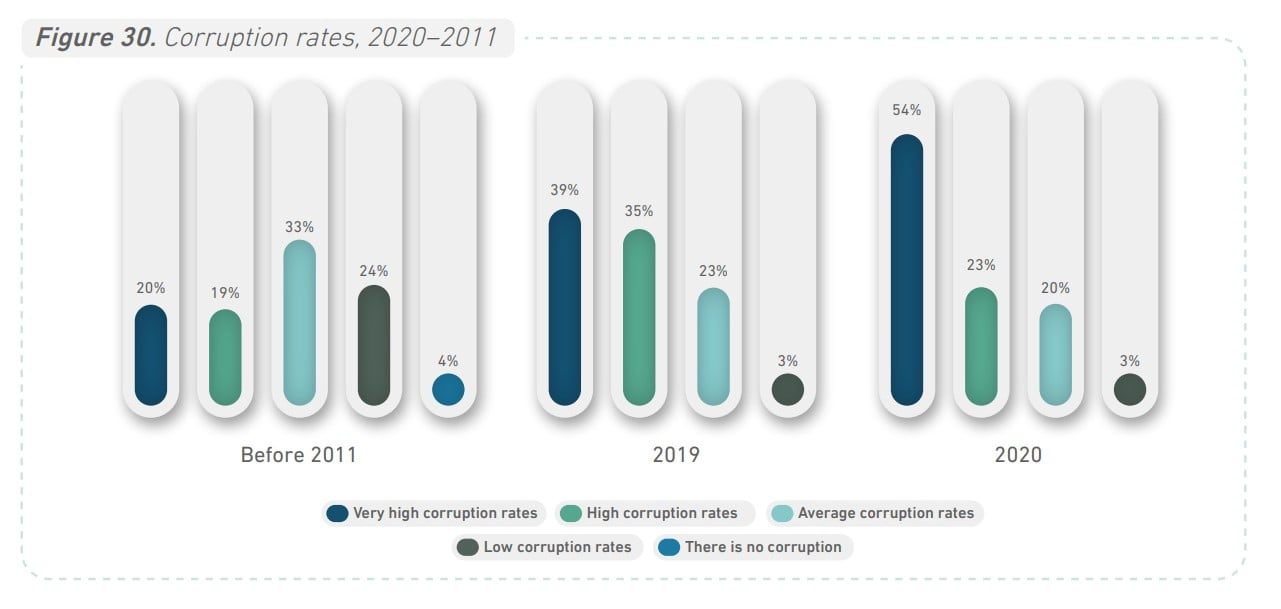
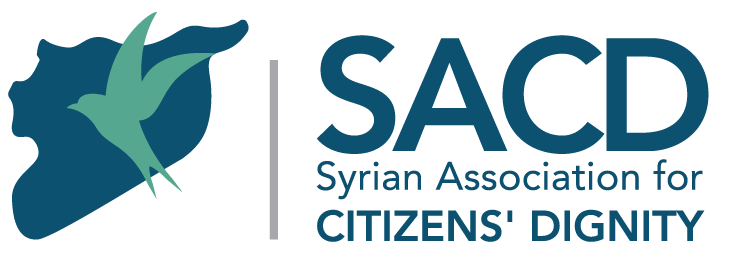
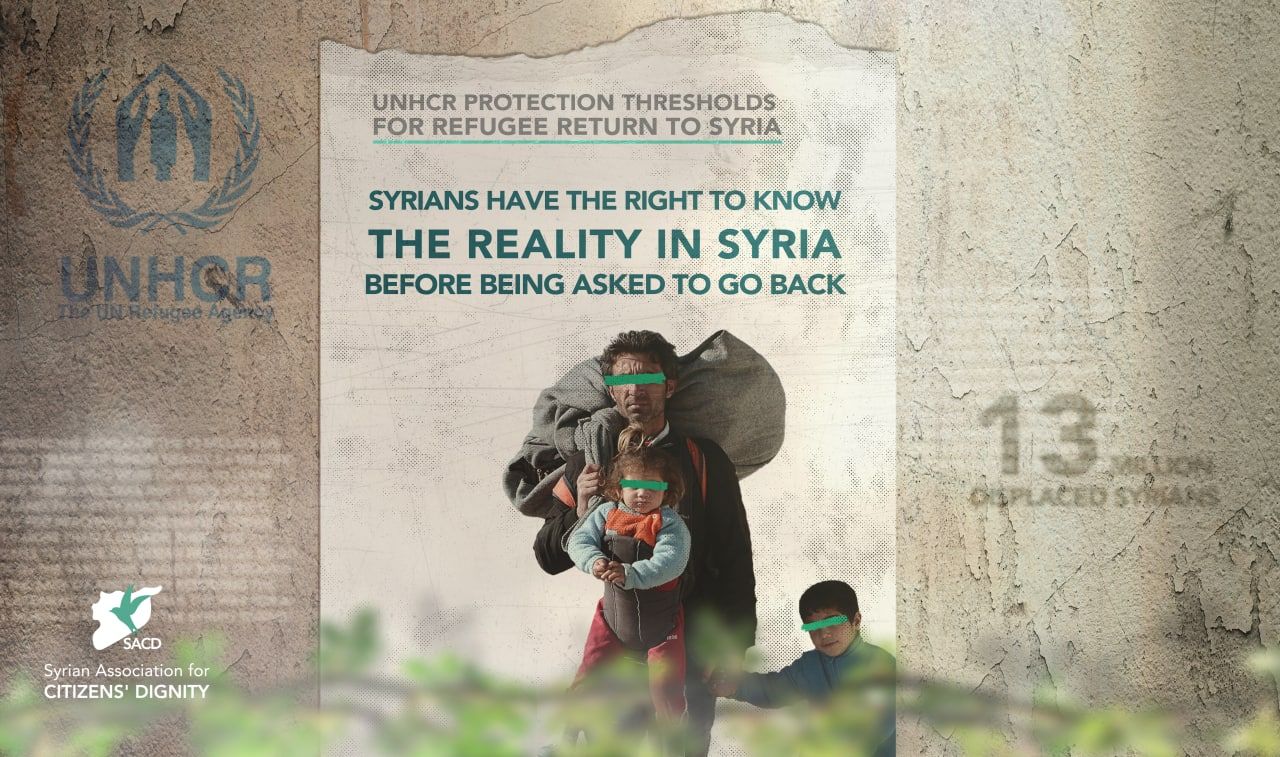

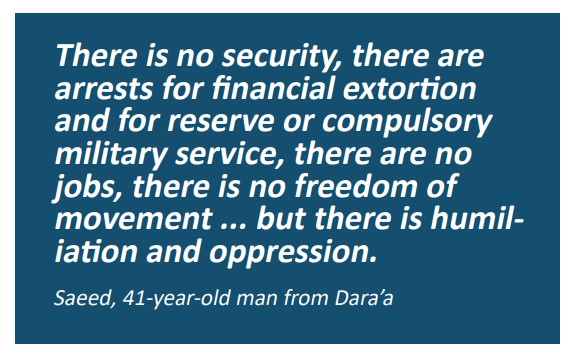 The annual
The annual 